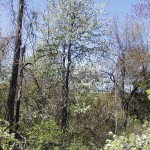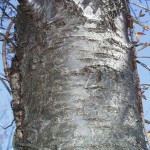Tuesday, May 6, 2014: In the Hudson Valley and southern New England, the time when sweet cherries are blooming is a critical time for managing X-disease. During cherry bloom, seedling Mazzard cherry trees growing in hedgerows and woodlots adjacent to stone fruit orchards can be easily detected because of their showy white flowers (Fig. 1). Seedling sweet cherry trees often become established via seeds carried by birds from cultivated cherry trees. These seedling trees can harbor X-disease and provide an inoculum source for commercial peach, nectarine, and sweet cherry orchards. While the seedling Mazzards are in bloom as they are right now, they should be marked for removal, and removal should be completed before June 1.
Do not confuse Mazzard seedling trees with shadbush (Amelanchier species) that are also blooming right now. Shadbush trees have a more wispy twig structure and the trunks on shadbush lack the large horizontally oriented lenticels common to trunks of Mazzard seedlings (Fig. 2). When removing potential hosts for X-disease, it is important to note that wild black cherry (Prunus serotina) is NOT a host for X-disease and need not be removed from orchard perimeters to control X-disease. Black cherry blooms later in the spring (Fig. 3) and has a much different flower structure than Mazzard seedling trees (Fig. 4).
- Fig. 1: Seedling sweet cherry in bloom adjacent to one of the orchards at the Hudson Valley Lab.
- Fig. 2: Bark on cherry seedling showing large horizontal lenticels.
- Fig. 3: Flower buds on wild black cherry (Prunus serotina).
- Fig. 4: Flower buds on Mazzard seedling cherry.
- Fig. 5: X-disease symptoms on Blackgold cherry (lower limb) compared to healthy fruit at harvest.
X-disease is one of the most difficult diseases to manage in peach, nectarine, and sweet cherry plantings in the Hudson Valley and southern New England. The pathogen that causes X-disease is a phytoplasma that can live only in phloem of infected plants or inside one of its insect vectors. Several leafhopper species are able to acquire the phytoplasma from infected chokecherry (Prunus virginianae) or sweet cherry trees and then transmit the pathogen to orchard trees. Transmission occurs during summer, and insecticidetreatments are not very effective for preventing transmission if infected chokecherry or sweet cherry trees are present within 500 feet of susceptible stone fruit crops.
Peach and nectarine trees are considered dead-end hosts for the disease, apparently because peaches and nectarines fail to develop the high titers of phytoplasma in the phloem that allow efficient acquisition of the pathogen. However, some experienced peach growers feel that peaches and nectarines may still contribute to slow spread of the disease even though such transmission has never been documented in controlled trials with insect vectors. Infected chokecherries and sweet cherries have phloem cells that are uniformly filled with the X-disease phytoplasma, and leafhoppers feeding on these trees can readily acquire the organisms and later transmit them to orchard trees.
The only control for X-disease is vigilant removal of wild hosts (chokecherry and Mazzard seedling trees) and regular removal of diseased sweet cherry trees as soon as symptomatic trees are diagnosed in sweet cherry plantings. X-disease in cultivated sweet cherries is best diagnosed during cherry harvest when diseased trees can be detected by their failure to ripen fruit on infected limbs (Fig. 5).





